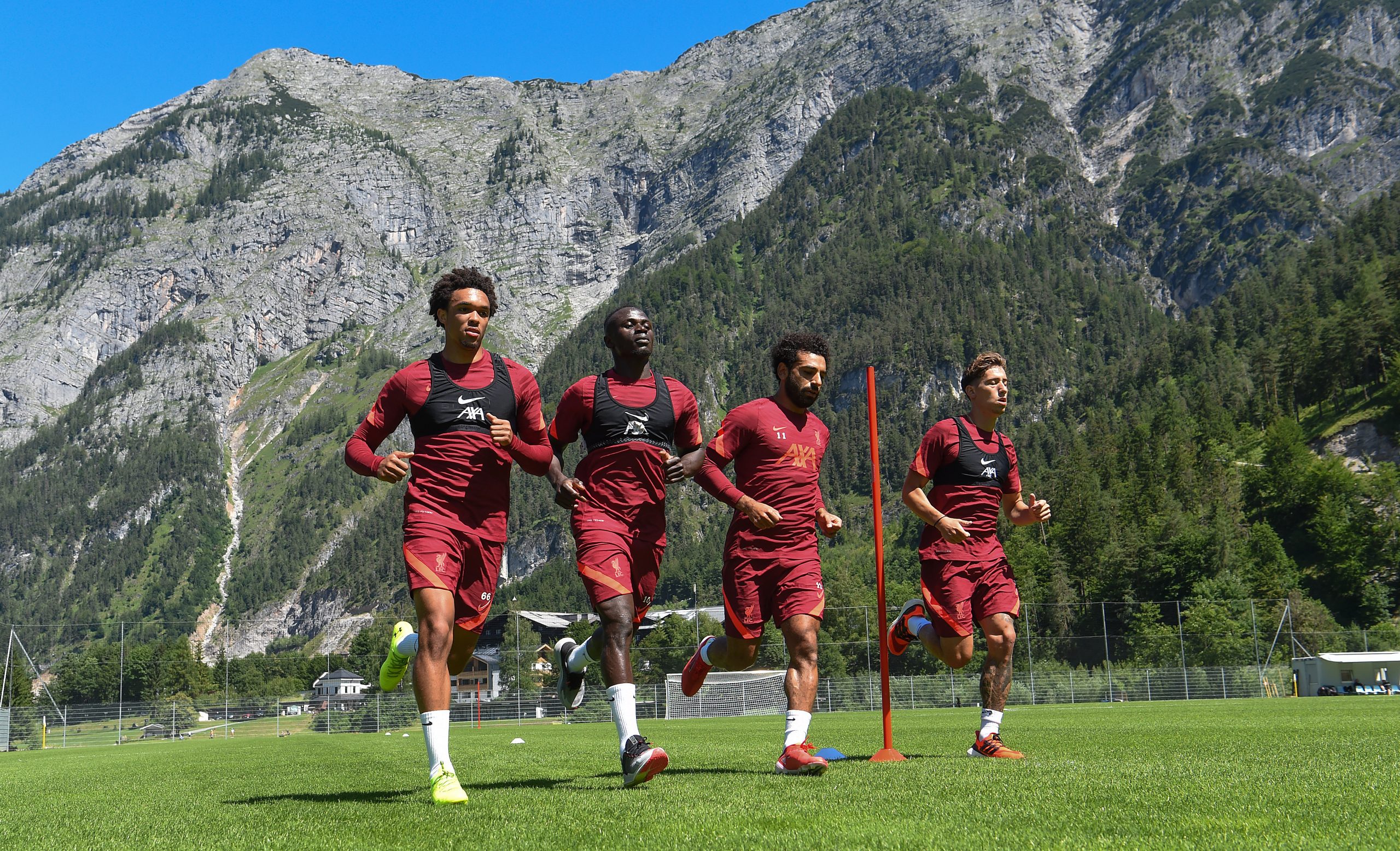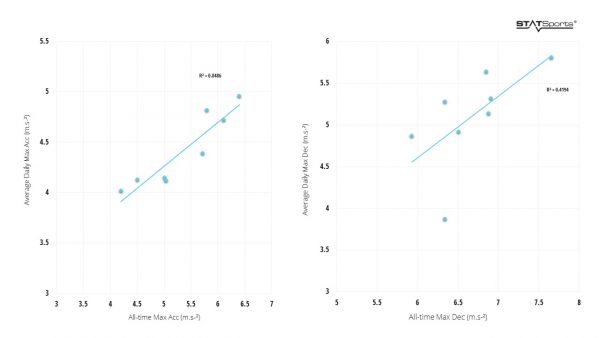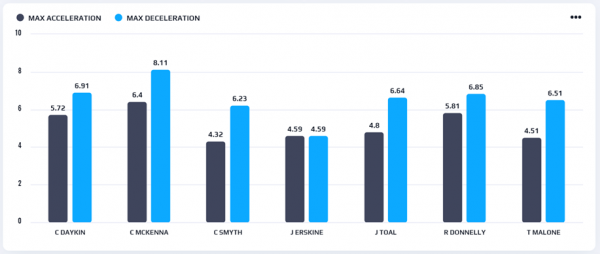
12 Jul Maximum Acceleration and Deceleration – Metric Considerations and Uses
High-intensity accelerations and decelerations (≥3 m.s-²) are extremely common in field sports with reports of up to 46 high-intensity accelerations and 73 high-intensity decelerations during match play in elite academy footballers [1]. Furthermore, accelerations and decelerations contribute significantly to the total high intensity running distances and sprinting distances in women’s football matches and occur more frequently during a match than any other running metric [2].
Athletes with better acceleration and deceleration capabilities will therefore gain performance benefits due to the high volume and intensity of such actions taking place in games. This, alongside the biomechanical stress and muscle damage associated with high-intensity accelerations and decelerations, shows the importance of monitoring these metrics across a squad [3].
This applied insight will look towards maximum accelerations and maximum decelerations as metrics and why they can be beneficial for a practitioner to use and monitor. Before discussing further, it is important to note that I will be referring to max acceleration and max deceleration in terms of an athlete’s maximum value for a given session. An athlete’s peak value over all sessions analysed will be referred to as their ‘all-time maximum’.
Correlation with Sub-Maximal Performance
The below images show correlations between athlete’s all-time maximum acceleration and deceleration and their average daily maximum acceleration/deceleration.

Although in this case only a small cohort was analysed, positive relationships are seen between both all-time maximum accelerations and average daily Maximum Acceleration and all-time Maximum Deceleration and average daily Maximum Deceleration.
This highlights how participants with a high max acceleration/deceleration capacity appear to have an increased sub-maximal performance across sessions. This may be due to a lower ‘metabolic cost’ or energy required to perform high acceleration/deceleration efforts during sessions.
For example, an athlete with a max acceleration of 6.5m.s-² may find it relatively easier to accelerate at a rate of 5.4 m.s-² compared to an athlete with a max acceleration of 6.0 m.s-² accelerating at the same rate.
There appears to be a common decrease in the number of high-intensity accelerations and decelerations in the second half compared to the first half across a range of sports [4]. This suggests that intense accelerations and decelerations could be particularly vulnerable to neuromuscular fatigue and consequently to an exacerbated risk of incurring injury. Understanding this will help practitioners further understand how their athletes can cope with game demands and prepare to make them more robust.
In a specific sporting context, high maximum values will help in many scenarios e.g., having to repeatedly and quickly change direction to press the opposition in football, or in rugby, making a line break and being able to accelerate away from the opposition.
A Method of Monitoring Athletes
It is already known that monitoring athletes provides valuable insight into an athlete’s health, physical status, and readiness to train or compete. Most commonly this takes place in the form of daily questionnaires and gym-based testing.
Jump variations are commonly used to test for neuromuscular fatigue and provides the practitioner with a way to quantify such fatigue. Monitoring an athlete’s daily and/or weekly maximum acceleration and deceleration may also give an insight into that athlete’s current physical status and ability to perform.
Both accelerations and decelerations can contribute significantly to a player’s load and are useful indicators of external load, therefore their value within athlete monitoring seems to be gaining increased importance [5].
Maximum acceleration and deceleration values on a session-by-session or weekly basis can be monitored against the athlete’s normal values. The advantage of this is that it provides a more sport-specific method of monitoring compared to commonly used gym-based methods.

The above example shows 7 player’s maximum acceleration and deceleration capabilities as recorded using Apex GNSS units. Just like with standard testing methods, comparisons can be made between squad members. Strengths and areas for individual improvement can be identified and visualised to inform field and gym-based training.
Using GNSS units to test for these capabilities provides several advantages; Results are in a sport-specific context and athletes can continuously be monitored for new max values as data is constantly being collected. This is also a more time efficient method of profiling players.
How to search for Maximum Accelerations and Decelerations on Sonra
Finding an athlete’s maximum acceleration and deceleration values is a simple and quick process through use of the Sonra desktop software.
Scanning for New Maximum Values
- Select the players and sessions you want to scan for new maximum values (You can scan multiple players and sessions at once).
- Select the additional features option in the top right of Sonra and go to ‘check for new max values’.
- Choose which value you want to scan for – Sonra will scan all selected players, sessions and drills.
- Players with new maximum values found will appear on screen. Tick the boxes and click on update to confirm changes.
For Session Maximum Values
- Add the ‘Maximum Acceleration’ and ‘Maximum Deceleration’ metrics to your dashboard and/or report.
- Select the player(s) and session(s) you want to view maximum values for.

Practical Considerations
Accelerations and decelerations are important actions in sport and as therefore should be considered when conducting GPS/GNSS analysis.
Athletes with greater maximal acceleration and deceleration capabilities appear to display higher sub-maximal performance on a day-to-day basis.
Monitoring daily and/or weekly maximum values compared to individual norms can provide an alternative or an additional method to monitoring fatigue.
Using GPS/GNSS measurements for maximum acceleration and deceleration provide a time-efficient and sport-specific alternative to standard testing methods.
Author details
Caomham Daykin, STATSports Sports Scientist
Email: [email protected]
References
- Tierney, P., Young, A., Clarke, N. and Duncan, M., 2016. Match play demands of 11 versus 11 professional football using Global Positioning System tracking: Variations across common playing formations. Human Movement Science, 49, pp.1-8.
- Griffin, J., Newans, T., Horan, S., Keogh, J., Andreatta, M. and Minahan, C., 2021. Acceleration and High-Speed Running Profiles of Women’s International and Domestic Football Matches. Frontiers in Sports and Active Living, 3.
- Gastin, P., Hunkin, S., Fahrner, B. and Robertson, S., 2019. Deceleration, Acceleration, and Impacts Are Strong Contributors to Muscle Damage in Professional Australian Football. Journal of Strength and Conditioning Research, 33(12), pp.3374-3383.
- Harper, D., Carling, C. and Kiely, J., 2019. High-Intensity Acceleration and Deceleration Demands in Elite Team Sports Competitive Match Play: A Systematic Review and Meta-Analysis of Observational Studies. Sports Medicine, 49(12), pp.1923-1947.
- Wing, C., 2018. Monitoring Athlete Load: Data Collection Methods and Practical Recommendations. Strength & Conditioning Journal, 40(4), pp.26-39.